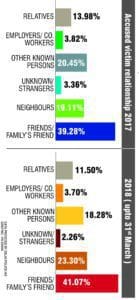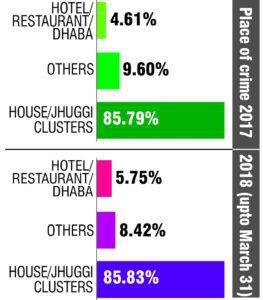While experts feel the ‘Rape Capital’ tag given by the media to Delhi is unfair, it seems to be true that most predators work in private spaces like homes, not in the public sphere
In Delhi, from 2017 to March 31, 2018, approximately 3.75 per cent rapes were committed by strangers while almost 96.5 per cent were by persons known to the victim. Which is perhaps why Delhi Police Special Commissioner Bhipendra Pathak believes most of the rape cases could not have been prevented by cops, as they happened within a family or friend network. Instead, he puts the onus on society, “which needs to change itself”, he tells Patriot.
There is a high incidence of incestuous rape and assault, and also those committed by neighbours, friends and acquaintances. Pathak points out that of all the cases, most perpetrators “were those meant to protect the child or were part of the family, very close family, like father, uncle, mama (mother’s brother)”.
Data provided by the Delhi Police HQ shows the number of reported rapes in the city at 393 in 2018, and the 2017 figure as 379 (from January to March 31). Reporting of molestation cases also came down from 630 (2017) to 549 (2018) and eve-teasing from 128 to 108.
Clearly, data with the police or even the National Crime Records Bureau (NCRB) cannot be deemed fully accurate as many incidents are never reported, especially if the victims are children.

Anuja Gupta, founder of the Rahi Foundation which works with survivors of child sexual abuse, points to the lack of education on what sexual abuse is, and India holding a family as being “sacrosanct”, where “children nor women have any rights.”
Citing the recent brutal rape and murder of an eight-year-old child in Kathua, she says outrage should not just be shown only when such a brutal attack happens, “of course, it’s condemnable,” but “people need to start talking and acknowledging that this kind of abuse has been taking place for generations in so many homes”. We need to “stop thinking that families are safe because this is the biggest site for violence.”
Gupta points out that if a child is available at home the opportunity to groom and psychologically manipulate him/her is ever present. One such person the Foundation is helping is X. She was four years old when her abuse at the hands of her own father began. “She was sexualised from a young age through sexual talk.” Then it became more intrusive, Gupta says. X’s father started entering her room, watching her undress. Then came the point when he started making her watch pornography, and getting her to masturbate him.

In these scenarios, Gupta says, “There’s no way to cope with it other than accommodate it. She knew no reality other than that. Can she tell her mother? Yes, but even that’s very hard.”
In this case, she didn’t tell her mother, until much later as an adult. The abuse went on till the age of 18. “She knew what was happening to her was wrong. But at the same time, she loved her father.” He was a “charming man, friendly with her friends and a good, doting father,” adding to the confusion. It was like a split personality, “of a father who was doting and then sexually abusing her”, she adds. “Coping with such things without any help nor phycological maturity” made X believe that the abuse was part of what was “supposed to happen”.
Later on, she finally told her mother. She found out that her sister was also being abused. All the events of her childhood and growing years had quite a lasting impact. She felt betrayed by her father, and wanted him to admit to his mistakes.
Commissioner Pathak believes there are three factors behind the number of incidents of child rape and molestation in Delhi. One is alcohol, “in almost 99 per cent of the cases the inebriated person who was not in his senses committed such a crime”. The second, Pathak says, is pornography. Through technology, “lot of bad things have emerged”, and the third he blames on the economic standing of families. “Because of the limited means of livelihood, they are staying in one room,” which Pathak says, sees cases like a father raping his daughter.
Gupta admits that while the cases the police come across may have seen such a pattern, but it “certainly isn’t the reality that they have to be drunk or watch porn” to rape. While “most molesters are men”, not “all men are not molesters”, and such a statement shows a “very simplistic understanding of the issue.”
Gupta also has a problem with the tag of Delhi being the “rape capital”, citing that such a phrase doesn’t serve any purpose.
But NCRB data shows the systemic abuse of women, much more than other cities in the country. The statistics from 2016 showed that one in every three cases of crimes against women in metropolitan cities took place in the capital, with 13,803 cases. Delhi reported 1,996 rape cases in 2016, up from 1,893 in 2015.
Pathak too thinks that the tag is unfair. “Let’s compare the cases of rape in Delhi per lakh population to that of Sydney, New York or London. You’ll find that in Delhi the violations are six times to eight times less.” He doesn’t believe that one of the reasons could be that people are not coming forward to report crime.
When a comparison is attempted, data from London and New York does seem high. According to the UK Metropolitan police website in the year 2017, London witnessed 7,503 rapes. Other sexual offences accounted to 12,059, making the total count of sexual offences to 19,562. The year 2016 saw 6,367 counts of rape and 11,211 of other sexual offences. In 2018, from January to February, there have been 1,235 rapes and 1,884 other sexual offences in the city. In New York City, there were 1,446 rapes reported in 2017, compared with 1,442 in 2016.
While city wise statistics are not available for Japan’s rape crime, the total in the country in 2017 was 1,852 and in 2016 was 2,332. Tokyo Rape Crisis Center did tell Patriot the numbers for rape in 2016 were 138, and 801 cases of indecent assault.
In the case of China, there’s no available data to tell the crime rate, but one does know, through many reports, that the rate would be high.
There’s a pattern to be seen in Asian nations versus that of the West — the crime rate and especially the low reporting, which points to how the cultures treat its women and children and their rights.
Pathak says the police takes every violation against a woman very seriously. But he wants a push for a focused education on gender sensitisation, “society in general and institutions in particular need to impress upon bringing up the female and male child equally”.
Delhi Police in its part has implemented various helplines. It also plans on recruiting more women for a “gender balanced Delhi Police”.
At the IT platform, they have the Himmat application, but which lacks users. There’s also the QR code which has been introduced in all cabs plying out of Delhi airport. “You get reconfirmed that the driver who’s driving the vehicle is the one that should be driving,”Pathak says. They are working to introduce it at New Delhi railway station and eventually to all modes of public transport.
In the case reported on Thursday, a woman hailed a cab from the IGI airport, and found some distance into the journey, the Uber driver masturbating. It was found that the driver was riding with a fake license and the one submitted to Uber was that of his brother. It is not known if the cab was QR code verified, as it should have been.





